Affiliate disclosure: This post may contain affiliate links. Please see our Privacy Policy.
Spruce beer is a fun way to enjoy spruce tips in season, and it’s a lot easier to make than most modern homebrewed beers. It’s made with just a few ingredients, and it only takes about a week from start to finish.
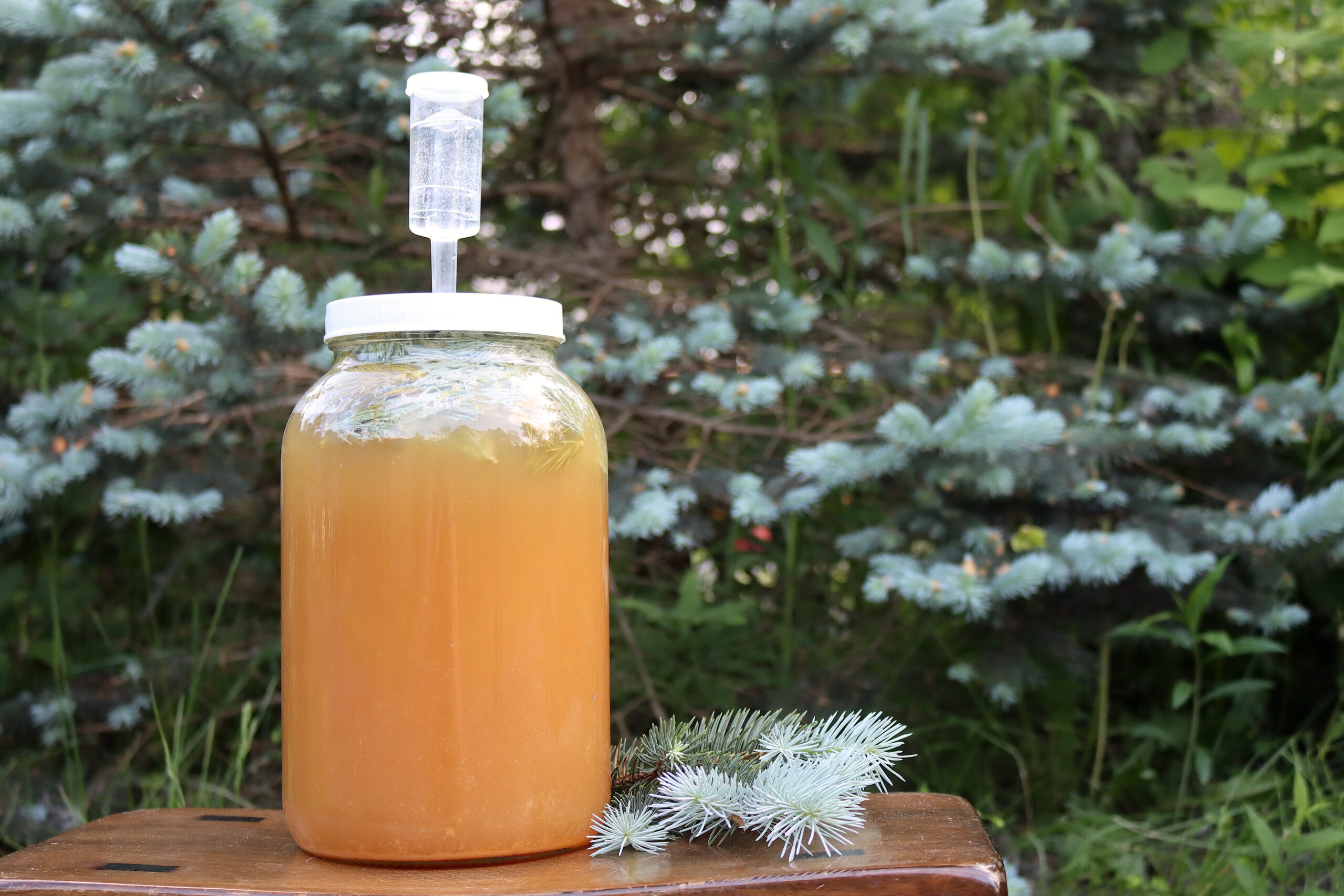
Spruce beer is a drink that dates back to the colonial era, and though tasty, it wasn’t what we’d consider a “beer” by modern standards. It was a lot closer to a ginger beer, just mildly alcoholic, carbonated, and intensely flavorful.
Historically, they were a lot less hung up on definitions when it comes to fermented beverages. They’d use any sugar source they could find, plus plants, wild or cultivated.
Often times, it was a mix of what was available, and archeological research shows that most early beverages were made with everything but the kitchen sink. Throw in honey, apple juice, grape juice, malt, herbs, maybe some figs…whatever will kick that alcohol content up.
And they weren’t bothered by semantics. An ale or a beer? Is this a mead or a melomel? Who cares! It tastes better than the local water, and that’s all that matters.
Spruce “beer” was first made in colonial America, and as the story goes, local indigenous tribes showed colonists how to make a drink from spruce that cured scurvy. It was a fresh infusion or decoction, so the natural vitamin C in the spruce was preserved, and it really did work (and still does today).
You can get similar effects by drinking spruce tip tea or pine needle tea, in which the tips are just immersed in hot water (rather than boiled for hours into a flavor extract).
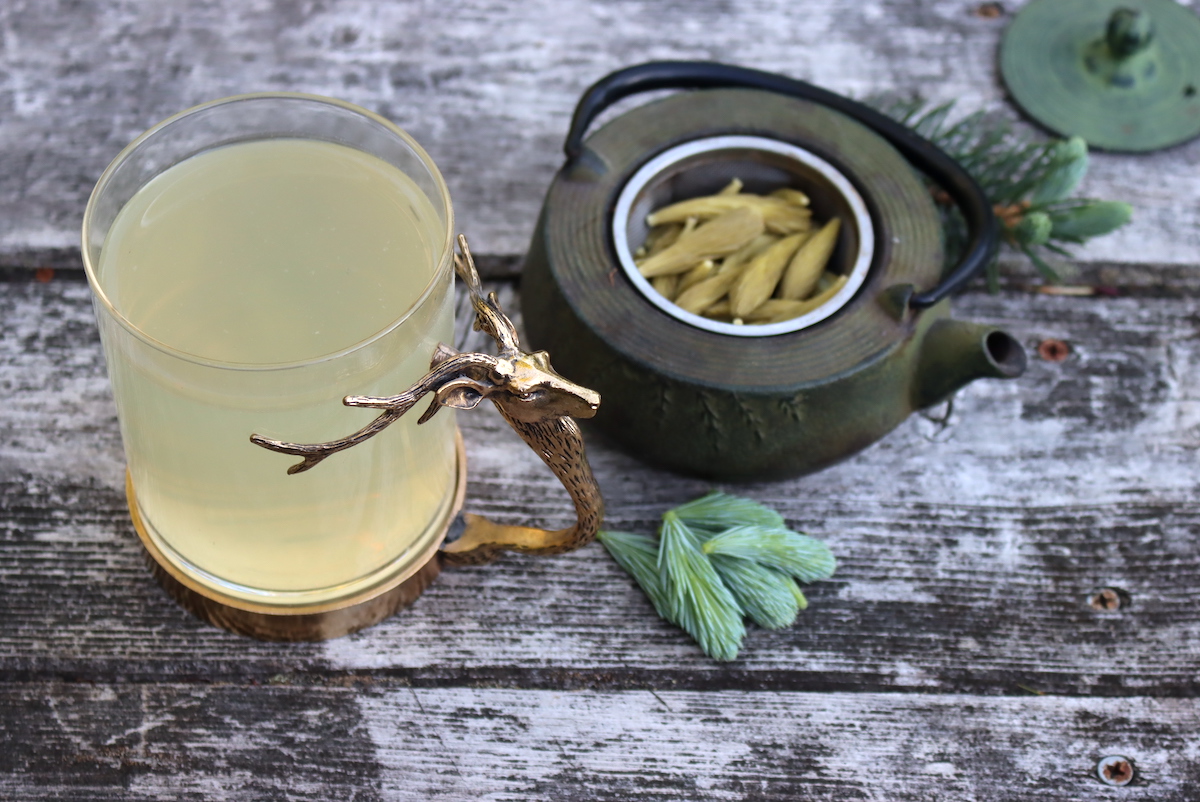
The colonists, however, just loved the taste, and they took spruce tips and branches and boiled them down into a concentrated spruce extract. When cooked like that, all the vitamin C is destroyed, but little matter…it was still marketed as a health tonic.
Since all they were really trying to do was sterilize drinking water, and add a bit of flavor to cover up the taste (especially when the water source might be a bit suspect), spruce beer actually was a health drink. Or, at least healthier than drinking the local water.
Recipes from the 1600s and 1700s start with boiling water, then you add a bit of molasses, about a pound per gallon, and then spruce extract, maybe a tablespoon per gallon. (Historically, it was sold in tiny bottles, or you could make your own by boiling down spruce branches or fresh spring tips into a concentrated tea extract.)
A bit of fresh yeast was added from a previous batch, and then it was fermented for just a few days before being bottled. It’d be light, just 2-3% alcohol at most, and carbonated since it was bottled while still actively fermenting. The flavor is sweet and bubbly, with a resinous pine-y citrus flavor from the spruce, along with a sweet caramel base from the molasses.
Though it’s called a beer, there wasn’t malt, and hops were added only occasionally for preservation, but they were less persnickety about such things before modern 21st-century labeling laws.
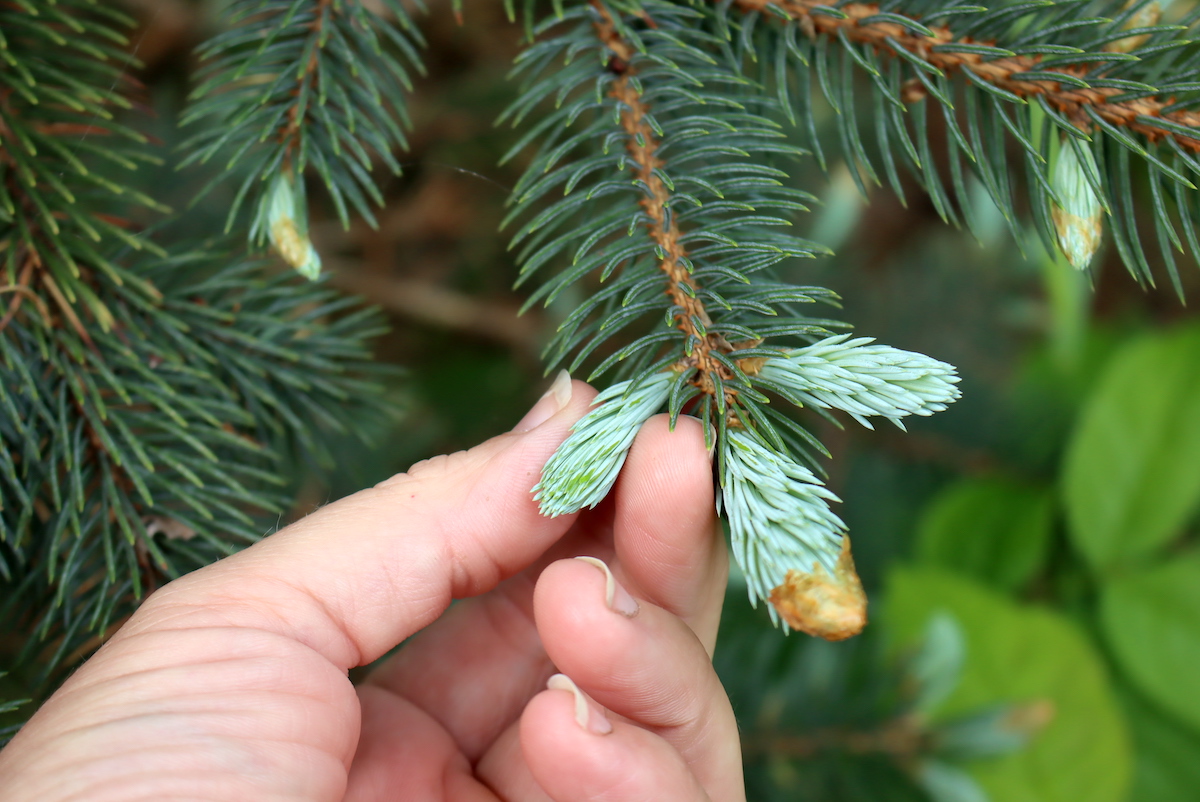
Ingredients for Spruce Beer
The ingredients listed, at least in most historical recipes, are deceptively simple. Usually, just water, spruce extract, molasses, and yeast.
The thing is, those ingredients didn’t necessarily mean what they do today.
Historically, molasses was a far cry from the dark, bitter bottles of blackstrap molasses you buy in the stores today. That was the bottom-of-the-barrel stuff, and most people, even the lower classes, had access to much milder and higher-quality molasses than we use today.
Historical “Molasses” was much more like what we call Treacle Syrup or Golden Syrup today. It’s kind of hard to get in the US (except online), but it’s popular in the UK and Scandinavia for traditional recipes, namely traditional Christmas cookies and gingerbread (but we use blackstrap molasses here in the US, making a very different, and harsher, cookie than they did back in the day).
In some places, maple syrup was called “Maple Molassas” or “Tree Molasses,” so in some cases, it would have meant maple syrup as well.
The yeast was added by the teacup full, and it would have been the “lees” or sediment from another fermentation batch (spruce beer or something else). That adds yeast nutrients since there’s nothing yeast love feasting on more than a combination of sugar and their fallen comrades, as well as live yeast.
A good modern substitute is light English ale yeast, like Sefale S-04.
Some recipes also use sugar sources like malt (as in modern beer), apple cider or maple syrup when available, hops (for preservation), and ginger, mace, or wintergreen (for flavor).
Honey was incredibly expensive in colonial America, so not a common ingredient, but there are pine or conifer flavorings in some traditional Scandinavian and Eastern European mead recipes that predate spruce beer…so it’s not out of the question either.
Oddly, fresh spruce or spruce tips aren’t in most historical recipes from the colonial US, and they used “spruce essence” instead. That’s because the preferred types of flavorful spruce (namely black spruce and blue spruce) only grew in Northern New England (like modern-day Vermont, where I am) and Canada.
If you’re getting fancy, you can make spruce beer with fresh spruce tips, but in a pinch, you can boil spruce branches into a concentrate (more resin flavor, some bitterness, and fewer citrus notes).
I’m using spruce tips or new spring growth, but they’re a bit past the prime “spruce tip” stage, where they’re tightly curled. Usually, you’d harvest them a bit earlier, with the “paper” still attached. They’re still wonderful for spruce beer, though…and much better than boiled branches.
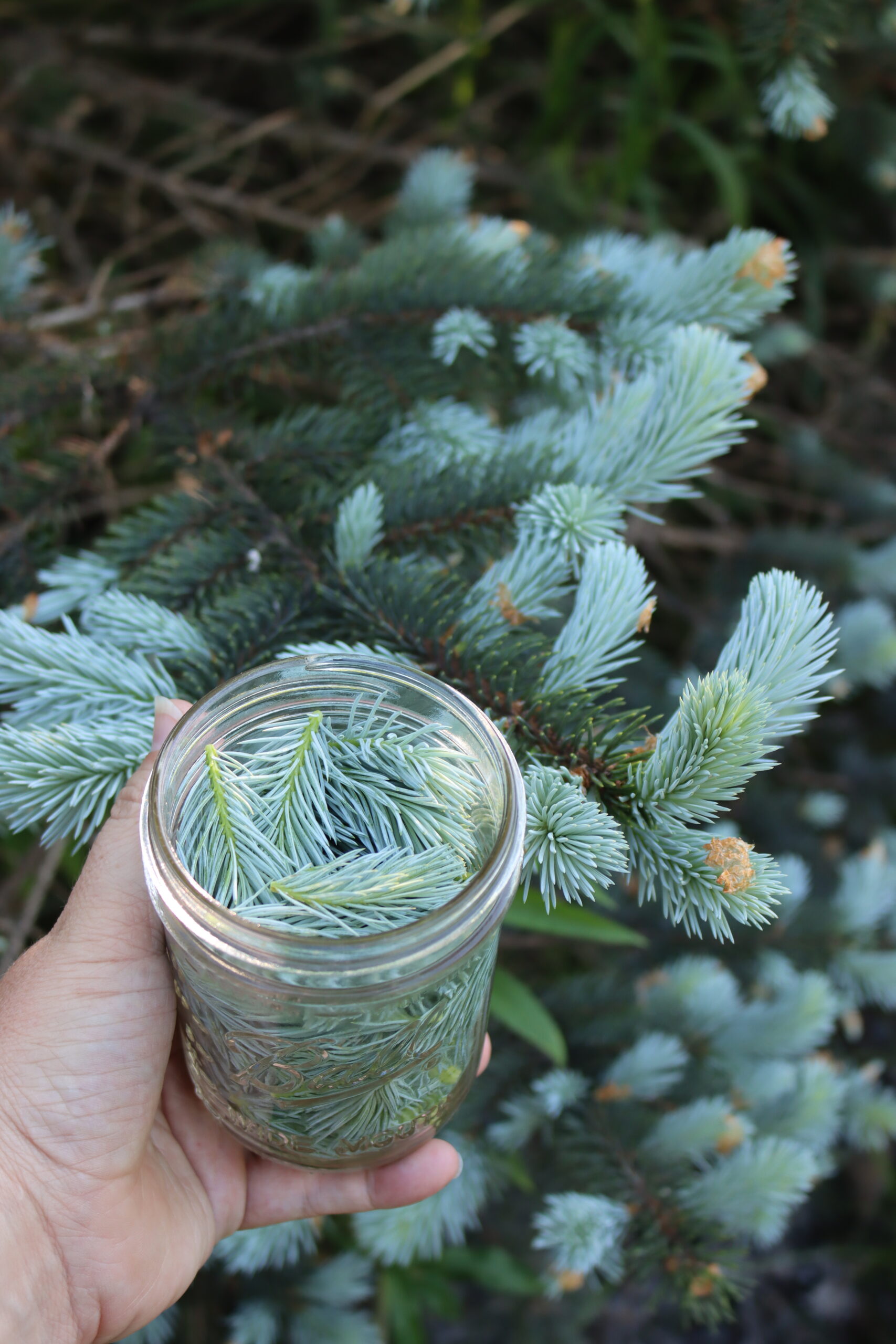
Even if you don’t have spruce branches or tips, no matter, spruce beer could be made with pine in a pinch, too, and nobody batted an eye, and they still called it “spruce beer” even though it didn’t contain spruce or malt.
The tips of white pine, fir, and eastern hemlock trees are also edible. Just avoid yew trees and ponderosa pine. (And, of course, be 100% sure of your ID, but that’s true when harvesting anything in the wild.)
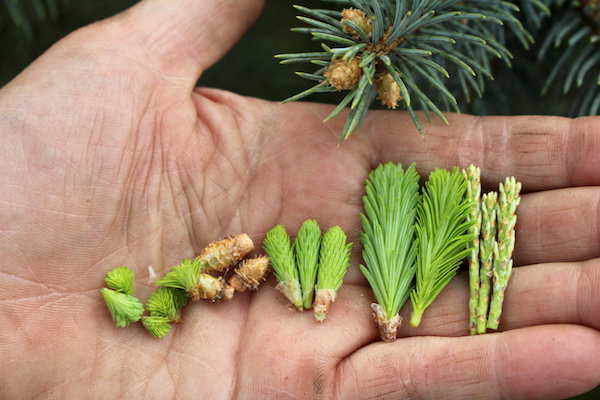
Don’t feel bad it you make yours with extract, that’s how the colonists mostly did it anyway. You can still buy spruce essence in small bottles for brewing spruce beer, but it’s a lot more concentrated than it used to be.
Old recipes say up to 1 Tbsp (or half-ounce) per gallon, but with the modern stuff, most recommend more like 1 tsp per 5 gallons…or no more than 1/4 tsp per gallon. It’s powerful stuff!
If you’re using fresh spruce tips, you’ll want about 3 to 6 ounces per gallon. A pint mason jar, relatively tightly packed, is 3 ounces of tips…so that’s 2 to 4 cups of spruce tips per gallon of spruce beer.
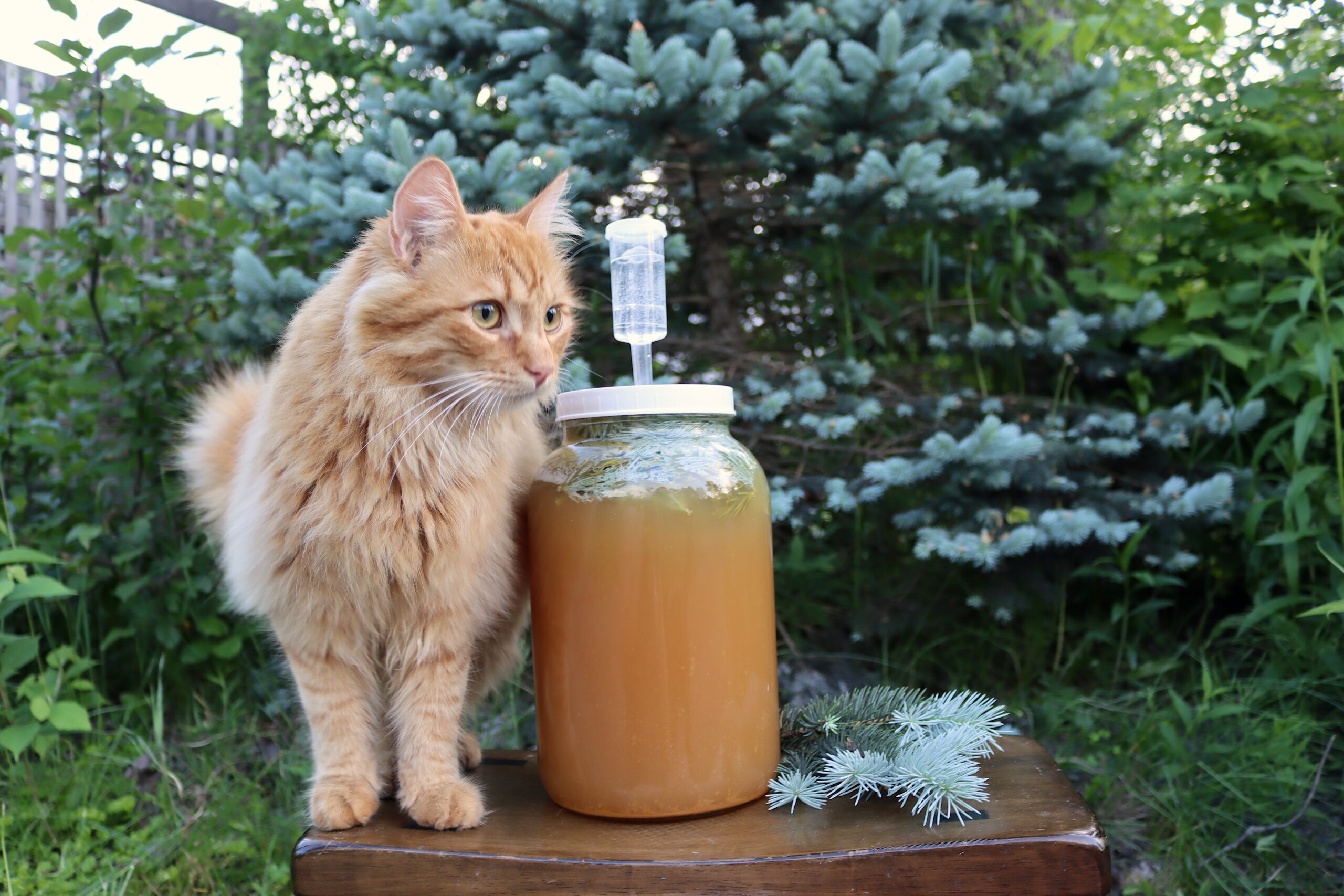
Historical Recipes for Spruce Beer
There are quite a few historical recipes for spruce beer that survive in old cookbooks, and here are a few to give you an idea:
American Cookery (1796) has one of the earliest recorded recipes for spruce beer. Her recipe uses hops, as this version was preserved for use in sea voyages. It’s a very large recipe, but it contains roughly 2 cups of molasses to a gallon of water, or about a pound, which is the amount of sweetener used in modern light-bodied beers.
It’s fermented about a week, which is similar to light beer which ferment for 7 to 10 days. The spoon of molasses in each bottle is for carbonation.
Here’s the original recipe:
“Take four ounces of hops, let them boil half an hour, in one gallon of water, strain the hop water, then add 16 gallons of warm water, two gallons of molasses, eight ounces of essence of spruce, dissolved in one quart of water, put it in a clean cask, then shake it well together, add half a pint of emptins [baker’s yeast], then let it stand and work one week, if very warm weather less time will do, when it is drawn off to bottle, add one spoonful of molasses to every bottle.”
The New Family Receipt Book (1819) contains a recipe for spruce beer that’s more than 200 years old. Back then, they thought that concentrating water by boiling it in half would yield a better beer. This one specifies treacle, which is much lighter than modern molasses:
“This cheap and wholesome liquor is thus made: take of water sixteen gallons, and boil the half of it; put the water thus boiled, while in full heat, to the reserved cold part, which should be previously put into the barrel or other vessel; then add 16 pounds of treacle or molasses, with a few tablespoonfuls of the essence of spruce, stirring the whole well together; add half a pint of yeast, and keep it in a temperate situation, with the bung hole open, for two days, till the fermentation be abated; then close it up, or bottle it off, and it will be fit to drink in a few days afterwards. In North America, and perhaps in other countries, where the black and white spruce firs abound, instead of adding the essence of the spruce at the same time with the molasses, they make a decoction of the leaves and small branches of these trees, and find the liquor equally good. It is a powerful antiscorbutic, and may prove very useful in a long sea voyage.”
This recipe for spruce beer comes from The Way To Live Well (1849):
“Allow an ounce of hops and a spoonful of ginger to a gallon of water. When well boiled, strain it, and put in a pint of molasses and half an ounce or less of the essence of spruce; when cool, add a teacup of yeast, and put into a clean tight cask, and let it ferment for a day or two, then bottle it for use. You can boil the sprigs of spruce fir in room of the essence.”
Another similar Spruce Beer Recipe comes from American Economical Housekeeper (1850):
“Take three gallons of water, lukewarm, three half-pints of molasses, a tablespoonful of essence of spruce, and the same quantity of sugar; mix all together, and add a gill of yeast; let it stand overnight, and bottle it in the morning. It will be ready for use in twenty-four hours.”
Dr. Chase’s Recipes (1869) includes more flavorings, as well as eggs, which settle out and clarify the beer:
“For 3 gals. water put in 1 qt. and pt. of molasses, 3 eggs well beaten, yeast 1 gill. Into 2 qts. of the water boiling hot put 50 drops of any oil you wish the flavor of; or mix 1 oz. each, oils sassafras, spruce and wintergreen, then use 50 drops of the mixed oils. Mix all, and strain; let it stand two hours, then bottle, bearing in mind that yeast must not be put in when the fluid would scald the hand. Boiling water cuts oil for beers, equal to alcohol.”
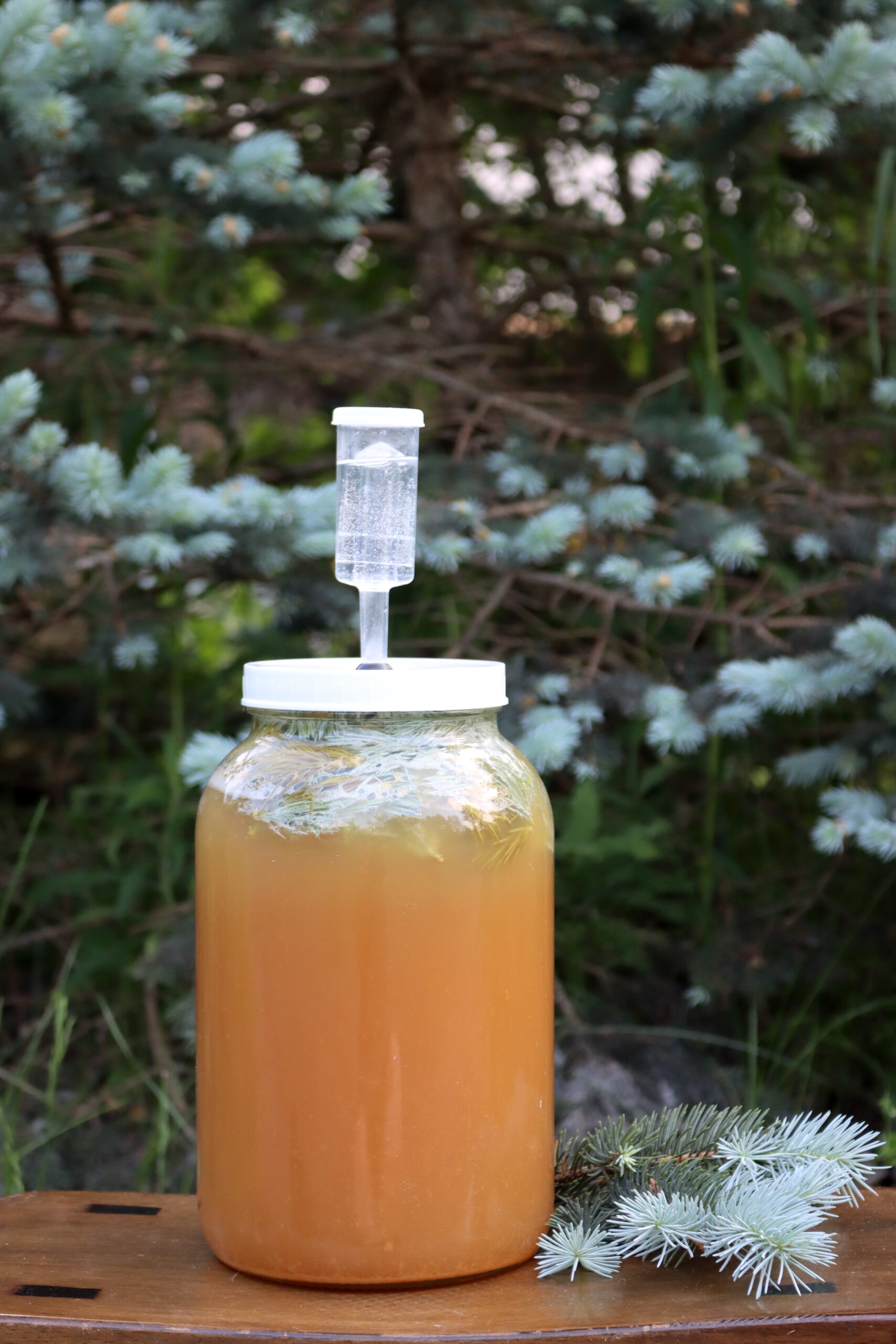
Other Spruce Drinks
So just because colonial spruce beer was more of a ginger beer or mildly alcoholic soda doesn’t mean that’s all you can make with spruce (or pine, or any other edible conifer).
You can, in fact, toss spruce tips, or spruce extract (homemade or commerially purchased) into just about any drink you’d like.
Spruce Infused Liqueurs
Spruce tip-infused vodka is incredibly simple (and delicious), and you can make just about any conifer-infused vodka for amazing winter cocktails.
Personally, I think it’d be better as an infused bourbon, but it’s up to you.
Spruce Hard Cider (or Spruce Cyser)
I’m a huge fan of spruce-infused hard cider after having fallen in love with a commercial version made here in Vermont called “Spruce Peak” by Stowe Cider. It’s made with spruce, sugar, fresh pressed cider and citrus. To make something remarkably like it, add about 4 to 6 ounces of spruce tips to my Apple Wine recipe.
(Yes, I know it says it’s a cider, but once you start adding sugar like that, it’s technically an apple wine by persnickety modern standards. If you want to make a true spruce cider, it’ll come out bone dry unless you stop fermentation early or add sugar to make it a wine. Here’s where you can read more on making hard cider.)
My favorite is spruce cyser, which is an apple mead or apple honey wine. I just add a bit of spruce tips into my apple cyser recipe.
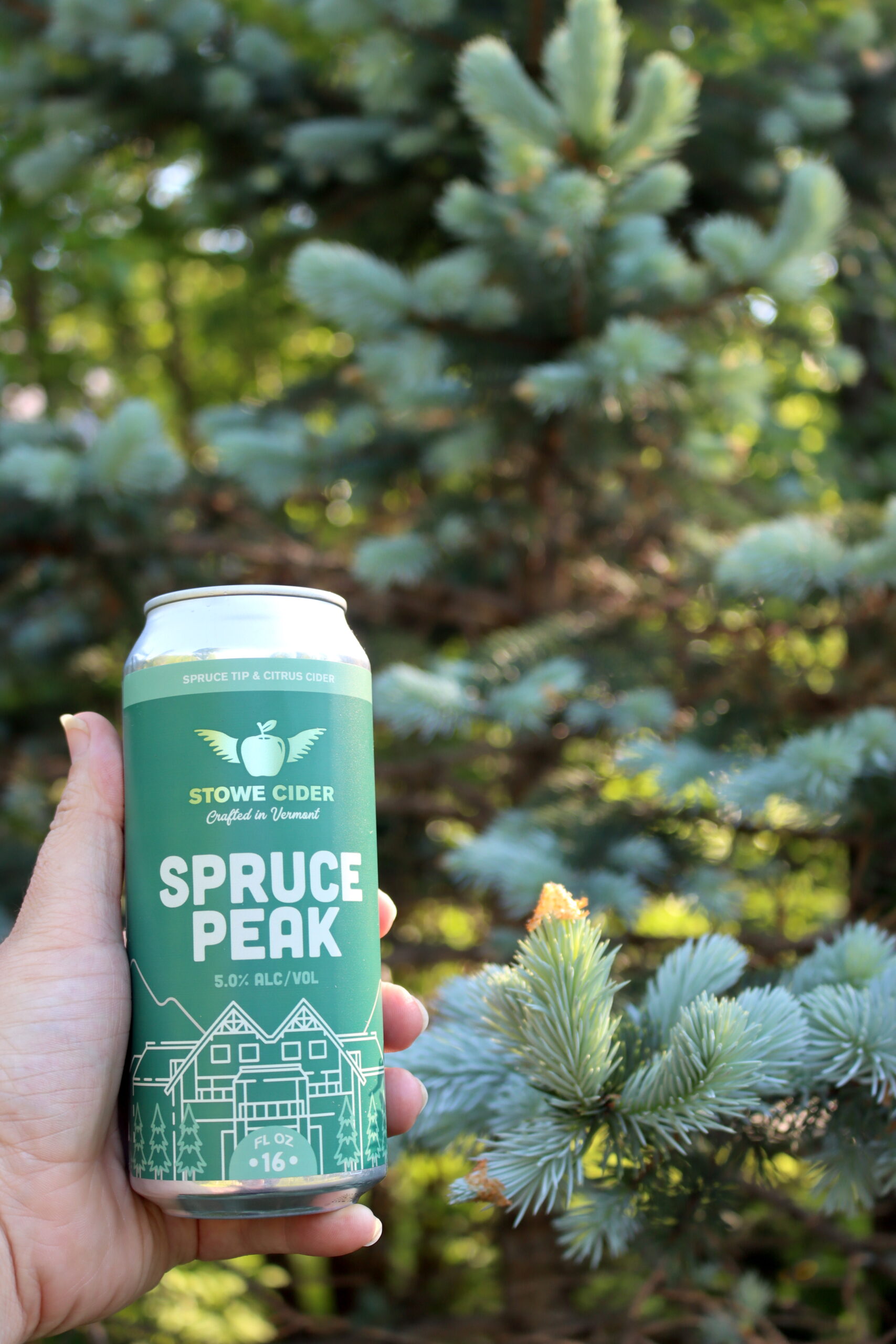
Spruce Mead
It was not traditional in Colonial America just due to the availability of honey, but conifer meads were made in the old world. You can use about a pint to a quart of spruce tips in primary or secondary, your choice.
Pine candles (or new shoots) give you a more intense resinous flavor but less citrus, but it’s equally good.
Here’s where you can read about making homemade mead, or more specifically, about making herbal or botanical wines and meads.
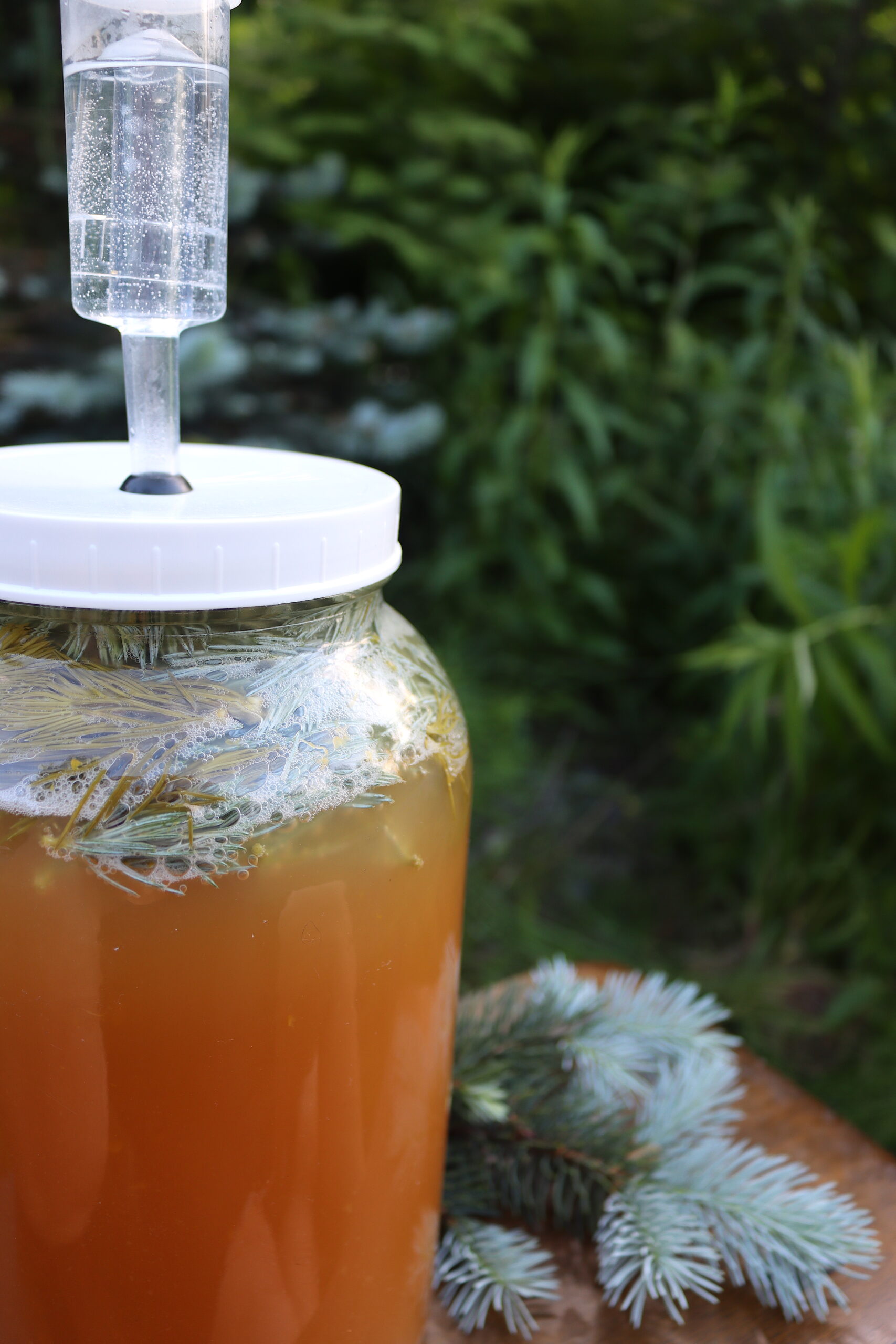
Homebrewed Spruce Beer
If you want homebrew beer with spruce tips, then no worries…just choose any beer recipe and put spruce tips in it. I know…not really guidance there, but your choice of malt and how you make the beer is going to dictate whether it’s light and fruity or rich and malty, and they’re all equally appropreate.
Generally, about half the hops are added with 30 minutes left in the boil (for a resin flavor), and the rest are pitched into the primary after you cool the wort (for citrus flavor notes). About 4 to 6 ounces in each, or 1/4 tsp of spruce, extract into primary instead.
You still add hops, and historically, the hops they had available when spruce beer was popular were wild…but they had a flavor profile similar to modern Liberty or Cluster hops, so go with those if it suits your fancy.
Here’s where you can read more on making homemade beer.
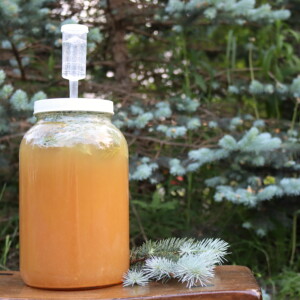
Traditional Spruce Beer Recipe
Ingredients
- 3 to 6 ounces spruce tips, 2 to 4 cups
- 2 cups golden syrup, treacle syrup, maple syrup, brown sugar or molasses
- 1 packet packet light ale yeast, such as Safale S-04
- 1 tsp yeast nutrient, or a handful of raisins
- Water to fill, about 3 quarts (un-chlorinated)
- Sugar for bottling, optional
Instructions
- Dissolve the sugar or syrup in about 2 quarts of clean, un-clorinated water. It helps to gently warm it until just dissolved, then allow it to cool to room temperature.
- Place the sugar water into a fermentation vessel or carboy. I like to use a wide-mouth 1-gallon carboy, as it’s easy to clean and works well with solids like spruce tips.
- Add the spruce tips and yeast nutrients.
- Dissolve the packet of yeast in a small amount of unclorinated water and allow it to rehydrate for about 10 minutes. Add that to the carboy with the other ingredients.
- Fill to within an inch of the top with more clean, unclorinated drinking water. Seal with an airlock and allow the mixture to ferment for about a week, until fermentation slows. In warmer weather, 4-5 days may be enough, in cooler weather, it may take 10 days.
- Bottle the beer in flip-top Grolsch bottles, adding a teaspoon full of sugar or syrup to each bottle. This is optional, but helps with carbonation. Allow the bottles to sit out for another 12-24 hours to carbonate, then store them in the fridge until you’re ready to drink them.
Notes
- The Townsends did a video recipe where they talked you through brewing it with either extract or fresh branches.
- Four Pounds Flour is a blog on historical gastronomy, and she has an excellent article on spruce beer.
- NPR and The Smithsonian both also have good historical write-ups that hit the high points and give you historical context.
Homemade Drinks
Looking for more fun homemade drinks (historical and otherwise)?
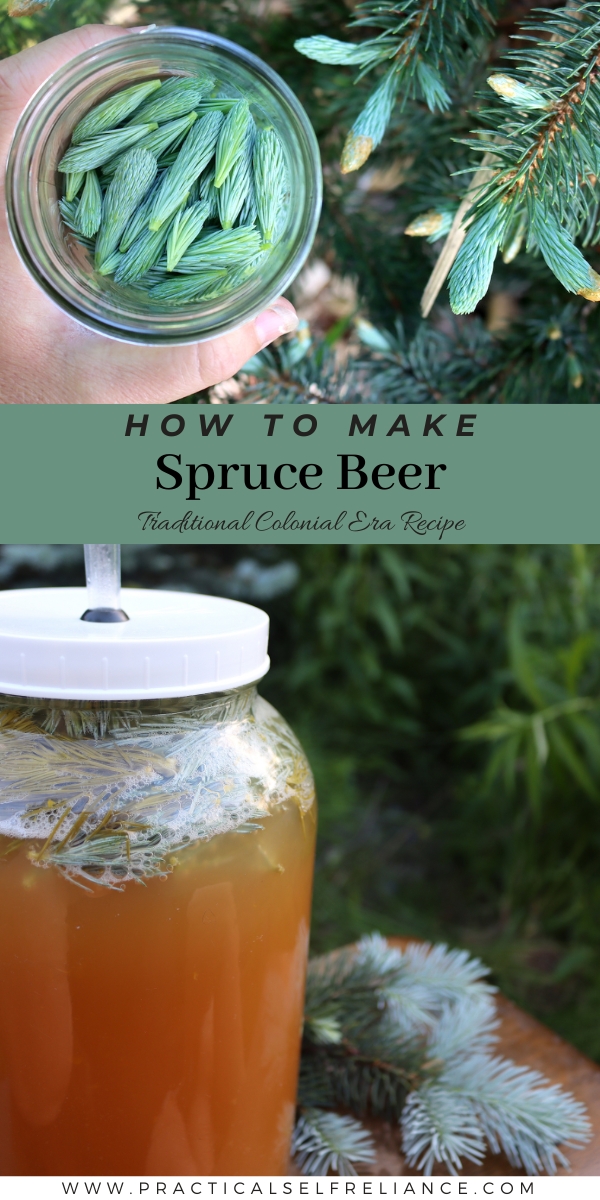

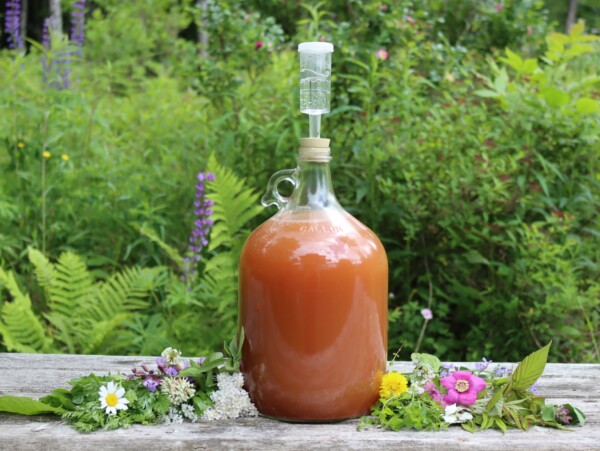
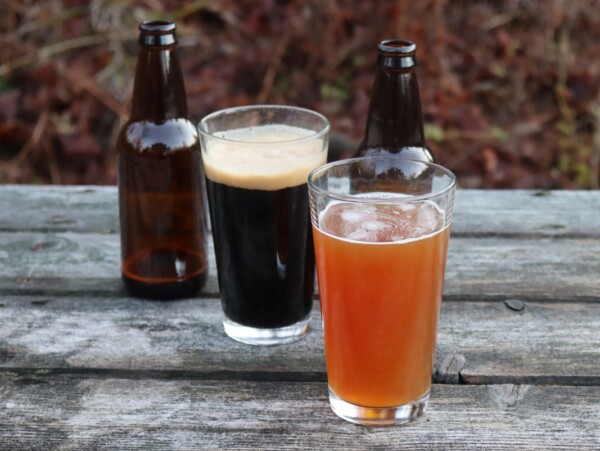
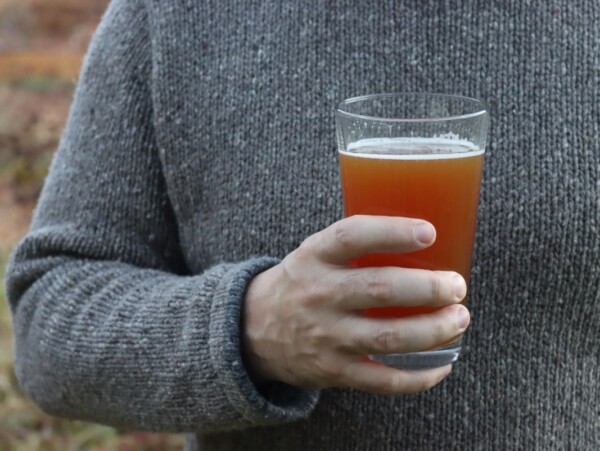










This one came out so darn good! The spruce flavor is amazing.